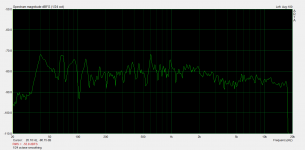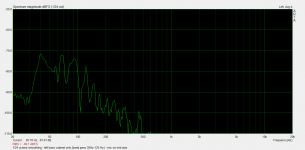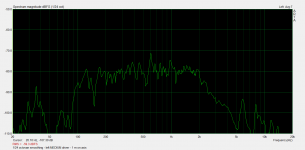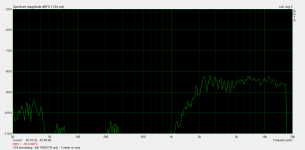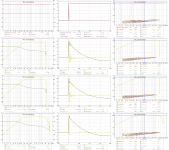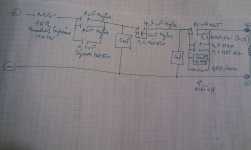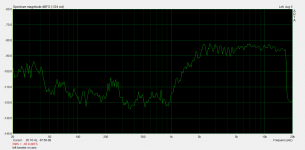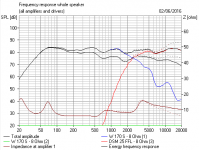thank you CLS,
I already know this site and these pages.
I am in a quite different situation, look at the photographs http://www.diyaudio.com/forums/multi-way/240636-acoustical-filter-tweeters-6.html#post3933192
There is a dome of foam to absorb below the aluminised dome. And the aluminium has always some resonances.
My question is : is it risky to full in the space between the foam dom and the aluminium dome ? Can it paddle off these ringing ?
Notice, there is no chamber behind the magnet (no center hole) which is plane : just a little hard dome of foam to do the job)
Please, anybody for an input about viscosity of Ferrofluid (20 years) or the cotton below the aluminized dome ?
I already know this site and these pages.
I am in a quite different situation, look at the photographs http://www.diyaudio.com/forums/multi-way/240636-acoustical-filter-tweeters-6.html#post3933192
There is a dome of foam to absorb below the aluminised dome. And the aluminium has always some resonances.
My question is : is it risky to full in the space between the foam dom and the aluminium dome ? Can it paddle off these ringing ?
Notice, there is no chamber behind the magnet (no center hole) which is plane : just a little hard dome of foam to do the job)
Please, anybody for an input about viscosity of Ferrofluid (20 years) or the cotton below the aluminized dome ?
Well I wanted to give the results as nobody answered to my last question here : http://www.diyaudio.com/forums/multi-way/240636-acoustical-filter-tweeters-6.html#post3933192
I was frighted to put medical cotton inside the aluminium dome because the small space and the heat... also because the gap which is near. As there is ferrofluid, i mean it avoids stranger fibers to enter in the gap.
How is the result : Wow : grat improvement, it paddle something. It's less peaky, brighty but stay lighty like a good tweeter without harchness. It's not yet the panacea and the ultime correction would be active EQ and phase correction I assume.
But here I believe I push the concept of acoustical filtering the farer I can !
Maybe other material inside the dome could help, longer and thicker fibers, but the space is so small between the foam dome and the inner aluminium dome !
I would like Atkins remeasure this fabulous speaker with all the correction I made because the initial review about the 500L Boston acoustics Lynnfield was rude and most of the sources ten years ago but planars were bad !
Arta here is not able to measure the variation before an after in a home environment, but the differences are great with ears for less listening fatigue without loss of resolution.... peaks attenuation, less third orders and lowers harmonic : I can't say. But if no dangerous, i advice to try it with aluminium cone and of course with all the Boston acoustic Lynfield serie... also for the fanatics who believed than genuine straps and amplifiers are the only way to tame this speaker !
I was frighted to put medical cotton inside the aluminium dome because the small space and the heat... also because the gap which is near. As there is ferrofluid, i mean it avoids stranger fibers to enter in the gap.
How is the result : Wow : grat improvement, it paddle something. It's less peaky, brighty but stay lighty like a good tweeter without harchness. It's not yet the panacea and the ultime correction would be active EQ and phase correction I assume.
But here I believe I push the concept of acoustical filtering the farer I can !
Maybe other material inside the dome could help, longer and thicker fibers, but the space is so small between the foam dome and the inner aluminium dome !
I would like Atkins remeasure this fabulous speaker with all the correction I made because the initial review about the 500L Boston acoustics Lynnfield was rude and most of the sources ten years ago but planars were bad !
Arta here is not able to measure the variation before an after in a home environment, but the differences are great with ears for less listening fatigue without loss of resolution.... peaks attenuation, less third orders and lowers harmonic : I can't say. But if no dangerous, i advice to try it with aluminium cone and of course with all the Boston acoustic Lynfield serie... also for the fanatics who believed than genuine straps and amplifiers are the only way to tame this speaker !
Boston Lynnfield 400L measurements
Hi,
I open again this old thread. I gave my word to xrq971, Wesayso, BYRTT members to measure my speakers in the spirit of the great job made in the Full range section : measurements sessions of many 5" to 2" inch drivers made by xrq971. It's also for the nice people whom helped me in this thread before : actual tweeter has a passive notch I added around 4.5 K Hz if I remember (not the last seen in this thread above) to tame some sibilance which worried me ! The near Boston Lynnfield 500 L serie which has the same drivers, XOs points according Boston Acoustic Datasheet can be found on Stereophile website here :Boston Acoustics Lynnfield 500L loudspeaker Measurements | Stereophile.com . The Boston has a lower low end. My Lynnfield 400L are given to 35 Hz to 30 K Hz, although a passive mechanical patented filter in front of the tweeter is said to damp the aluminium cone peak around 20 K Hz !
XOs on both speakers are 125 Hz & 2600 Hz ; but look at my measurement below, XO of the 400 L seems to have its tweeter XO nearer than 2 K Hz than 2.6 K Hz !
I'm a beginner at measurement sport (advices are welcomes)! reccording environment :
Mic: ISEM EMX-7150 - (calibrated with both semi-reverb and without : so 2 correction files)
PC - laptop Windows 10 (x64) - Intel I5-8 GoRam
soundcard : external EMU Pre Track http://www.creative.com/emu/products/product.aspx?pid=17511 : 24-bit/192kHz A/D and D/A converters (A/D and D/A: 112dB measured SNR performance ; A/D converter: AK5385 ; Phantom supply in class A for the mic.
ASIO driver from EMU was keeped. Drivers are for Windows 7 (x 64) as the W 8.1 & 10 do not exist; it seems to work ! Previous tests of this blog were made with a XP Pro laptop with the same soundcard but a EMC-8000 non calibrated mic).
I loaded also Ohms Impulse but had no time this week end but for the last Arta 1.85 from where come those graphs below !
Step Sin 20 Hz to 20 K Hz file played through AYA2 boosted DAC ! The External SoundCard iIt's a first measurements s just feeded by USB, I have the possibility to put an external PS though.
These are my first measurements ! Calib files non loaded to beginn as BYRTT member asked me (mic is said to be very linear stock without its calib correction : the idea is to compare !)
Left speaker reccorded : 1 meter from the rubber mid cone (look at pictures on this thread to understand why : passive mechanical filter is in front of it and it's impossible to move it.
A rapid calcul of the volume of the room give a 133 Hz Scrhoeder frequency.
Hi,
I open again this old thread. I gave my word to xrq971, Wesayso, BYRTT members to measure my speakers in the spirit of the great job made in the Full range section : measurements sessions of many 5" to 2" inch drivers made by xrq971. It's also for the nice people whom helped me in this thread before : actual tweeter has a passive notch I added around 4.5 K Hz if I remember (not the last seen in this thread above) to tame some sibilance which worried me ! The near Boston Lynnfield 500 L serie which has the same drivers, XOs points according Boston Acoustic Datasheet can be found on Stereophile website here :Boston Acoustics Lynnfield 500L loudspeaker Measurements | Stereophile.com . The Boston has a lower low end. My Lynnfield 400L are given to 35 Hz to 30 K Hz, although a passive mechanical patented filter in front of the tweeter is said to damp the aluminium cone peak around 20 K Hz !
XOs on both speakers are 125 Hz & 2600 Hz ; but look at my measurement below, XO of the 400 L seems to have its tweeter XO nearer than 2 K Hz than 2.6 K Hz !
I'm a beginner at measurement sport (advices are welcomes)! reccording environment :
Mic: ISEM EMX-7150 - (calibrated with both semi-reverb and without : so 2 correction files)
PC - laptop Windows 10 (x64) - Intel I5-8 GoRam
soundcard : external EMU Pre Track http://www.creative.com/emu/products/product.aspx?pid=17511 : 24-bit/192kHz A/D and D/A converters (A/D and D/A: 112dB measured SNR performance ; A/D converter: AK5385 ; Phantom supply in class A for the mic.
ASIO driver from EMU was keeped. Drivers are for Windows 7 (x 64) as the W 8.1 & 10 do not exist; it seems to work ! Previous tests of this blog were made with a XP Pro laptop with the same soundcard but a EMC-8000 non calibrated mic).
I loaded also Ohms Impulse but had no time this week end but for the last Arta 1.85 from where come those graphs below !
Step Sin 20 Hz to 20 K Hz file played through AYA2 boosted DAC ! The External SoundCard iIt's a first measurements s just feeded by USB, I have the possibility to put an external PS though.
These are my first measurements ! Calib files non loaded to beginn as BYRTT member asked me (mic is said to be very linear stock without its calib correction : the idea is to compare !)
Left speaker reccorded : 1 meter from the rubber mid cone (look at pictures on this thread to understand why : passive mechanical filter is in front of it and it's impossible to move it.
A rapid calcul of the volume of the room give a 133 Hz Scrhoeder frequency.
Attachments
Last edited:
Eldam thanks plots and nice documentation, looks like that especially 6kHz and 8kHz resonances from mid add to tweeter response in the system full range plot, maybe also the two mid resonances above 6/8kHz influence when one compare tweeter response verse system full range plot but they probably make dips (cancel) instead of peaks (sum).
thanks for the inputs,
If you want I make some measurements process : with calib files, old mic, listening position with different setup, just ask !
I have to read a little Olhms Inpulse manual before playing in the living room !
I surely made some protocol errors but it's a beginning ! I will try also THD, phase, etc ! As you see, on listening position, the curve should dive when going to the mid & treble ranges. It's already the case at 1 meter on axis with just the left speaker playing...(I damped the floor between the speaker and the mic; left speaker is at its usual position, so not putted on the middle of the room for a measurement farer of the walls ! Here the usual position is farer than 1.2 meter from side and front wall).
I find the notch added to be good at ears, better than without ! but as it's changing everything like phase for instance, I plan to remove it and measure again... but not yet ! Next measurementq will be like those ones with the notch keeped to have a concistency with the 1 meter on axis measurement...
If you want I make some measurements process : with calib files, old mic, listening position with different setup, just ask !
I have to read a little Olhms Inpulse manual before playing in the living room !
I surely made some protocol errors but it's a beginning ! I will try also THD, phase, etc ! As you see, on listening position, the curve should dive when going to the mid & treble ranges. It's already the case at 1 meter on axis with just the left speaker playing...(I damped the floor between the speaker and the mic; left speaker is at its usual position, so not putted on the middle of the room for a measurement farer of the walls ! Here the usual position is farer than 1.2 meter from side and front wall).
I find the notch added to be good at ears, better than without ! but as it's changing everything like phase for instance, I plan to remove it and measure again... but not yet ! Next measurementq will be like those ones with the notch keeped to have a concistency with the 1 meter on axis measurement...
Nice! You've kept your word 🙂. Let the games begin! It is fun stuff to learn what you are listening to. I expect the tweeter to go up way higher and not drop off that fast. Maybe try to record at a higher sample rate to be able to see that?
The Stereophile link shows way more extension so it would be nice to actually be able to measure that yourself. It seems the measurement just falls off suddenly and it really shouldn't. Not with those tweeters!
The Stereophile link shows way more extension so it would be nice to actually be able to measure that yourself. It seems the measurement just falls off suddenly and it really shouldn't. Not with those tweeters!
On my UMIK-1 I decided to set the upper sweep limit to 24kHz one day and lo and behold - I see all sorts of things like a 22kHz peak that was invisible before. That peak may be ultrasonic but it's ring makes a difference.
The file played is a 20 Hz-20k Hz swept tone and come from a site advised in this thread on a previous post.
The sampling frequency I choose for the A/D conversion was low : 44.1 😀...
Next step : try to understand more what I did... and measure again !
Can we play higher swept tones than 20 K when plugin the sound card on the pre in Arta or Ohms Impulse ?
The mic is given to 20 K Hz , but maybe he can "hear" a little more...although at this price I'm really not sure. But it could be fun to see the aluminium tweeter cone peak like Stereophile did ! J. Atkinson said the mechanical filter (se pictures in previous posts) didn't targett the peak ! There are also maybe inconcistency in the production : drivers are all from Boston Acoustic ! Don't know if made outside the Lynnfield factory ?
Measurements were made with the filters as the speaker has tri-amp possibilities ! But is it risky to measure the 5" aluminium mid in direct without a serie cap for protection ? Any interrest as I can't putt it on a IE bafle ? The measurement will have the bafle step of the speaker bafle !
to be continued...
PS : guys, would you say it's an awfull speaker seiinf the first graph ?
The sampling frequency I choose for the A/D conversion was low : 44.1 😀...
Next step : try to understand more what I did... and measure again !
Can we play higher swept tones than 20 K when plugin the sound card on the pre in Arta or Ohms Impulse ?
The mic is given to 20 K Hz , but maybe he can "hear" a little more...although at this price I'm really not sure. But it could be fun to see the aluminium tweeter cone peak like Stereophile did ! J. Atkinson said the mechanical filter (se pictures in previous posts) didn't targett the peak ! There are also maybe inconcistency in the production : drivers are all from Boston Acoustic ! Don't know if made outside the Lynnfield factory ?
Measurements were made with the filters as the speaker has tri-amp possibilities ! But is it risky to measure the 5" aluminium mid in direct without a serie cap for protection ? Any interrest as I can't putt it on a IE bafle ? The measurement will have the bafle step of the speaker bafle !
to be continued...
PS : guys, would you say it's an awfull speaker seiinf the first graph ?
Last edited:
Think measurements at HF is interesting and would like to get best understanding to get them as correct as possible.
wesayso good spotted the steep HF drop off, myself hadn't 😱
xrk971 example saying it's ringing makes a difference my thought is its because the amplitude energy actually is there but bandwidth limiting mic in this case works as a kind of notch filter cutting the ringing.
Below a good example with opposite effect as to xrk971 because in example we get more ringing running bandwidth lower, reason here is f3 cut is at 20kHz with BW2 slope and lowering sample rate bandwidth push to BW2 slope making it more steep than BW2 and thereby a more ringing IR/SR. First plot is zero filter then three with a IRR band pass from BW2 at 180Hz to BW2 at 20kHz but their difference is soundcard run 44,1/48/96kHz bandwidth. At 96kHz measurement thinks its interesting no excess phase in minimum phase starts tracking actual phase inside audio band.
Don't know if Eldam has run a calibration for his soundcard because that could also push to the plots roll off making it steeper. Soundcard calibration up precision our measurements, we just need to do them, but why do our microphone calibration files stop at 20kHz when they typically is calibrated to reference that has far more bandwidth. Eldam talks about can mic "hear" a little higher, Zaphs measurements go far higher and is with a ECM8000 where mic cable has been within calibration process too, also member TTM show higher reach with his EMM-6 and supported Dayton Audio calibration file.
Eldam to protect driver if you sweep your mid or tweeter from inside REW the sweep dialog menu gives you possibility to set any higher "start frq" before sweep.
Find the attached Jeff Bagsby pdf doc very good knowledge regarding measurements "How to Achieve Accurate In-Room Quasi-Anechoic Free-Field Frequency Response Measurements Down to 10 Hz". Also he and Charlie Laub share more magic speaker tools here software.
wesayso good spotted the steep HF drop off, myself hadn't 😱
xrk971 example saying it's ringing makes a difference my thought is its because the amplitude energy actually is there but bandwidth limiting mic in this case works as a kind of notch filter cutting the ringing.
Below a good example with opposite effect as to xrk971 because in example we get more ringing running bandwidth lower, reason here is f3 cut is at 20kHz with BW2 slope and lowering sample rate bandwidth push to BW2 slope making it more steep than BW2 and thereby a more ringing IR/SR. First plot is zero filter then three with a IRR band pass from BW2 at 180Hz to BW2 at 20kHz but their difference is soundcard run 44,1/48/96kHz bandwidth. At 96kHz measurement thinks its interesting no excess phase in minimum phase starts tracking actual phase inside audio band.
Don't know if Eldam has run a calibration for his soundcard because that could also push to the plots roll off making it steeper. Soundcard calibration up precision our measurements, we just need to do them, but why do our microphone calibration files stop at 20kHz when they typically is calibrated to reference that has far more bandwidth. Eldam talks about can mic "hear" a little higher, Zaphs measurements go far higher and is with a ECM8000 where mic cable has been within calibration process too, also member TTM show higher reach with his EMM-6 and supported Dayton Audio calibration file.
Eldam to protect driver if you sweep your mid or tweeter from inside REW the sweep dialog menu gives you possibility to set any higher "start frq" before sweep.
Find the attached Jeff Bagsby pdf doc very good knowledge regarding measurements "How to Achieve Accurate In-Room Quasi-Anechoic Free-Field Frequency Response Measurements Down to 10 Hz". Also he and Charlie Laub share more magic speaker tools here software.
Frq response looks nice 🙂 but think a phase plot will reveal IRR XO points and not as flat.PS : guys, would you say it's an awfull speaker seiinf the first graph ?
Attachments
Last edited:
Thanks BYRTT,
A lot of homeworks, cool ! First : calibration of the soundcard : I totally forgot this point !
A lot of homeworks, cool ! First : calibration of the soundcard : I totally forgot this point !
Thanks X for your message in the other thread !
The best I can do is to remove the acoustical filter of the tweeter !
The acoustical filter of the mid can't be removed : look at this picture to understand : Résultats Google Recherche d'images correspondant à http://air-pulse.com/UserFiles/Image/Lynnfield-500L-P23.gif
& http://images.google.fr/imgres?imgurl=http://www.av1.co.il/_/rsrc/1271354007344/loudspeakers/aad-by-phil-jones/Boston%252520Acoustics%252520AAD.jpg&imgrefurl=http://www.av1.co.il/loudspeakers/state-of-the-art&h=274&w=522&tbnid=tqH78dwHOcypmM:&docid=ahHVAyq_bwP7rM&ei=JANTVqqOBofgaMqriLAB&tbm=isch&iact=rc&uact=3&page=1&start=0&ved=0ahUKEwiqsLbVwqbJAhUHMBoKHcoVAhYQrQMIPDAJ
picture is verry little but photograph of the raw driver are very rare : a unique piece of the market of the 5" medium drivers !
The best I can do is to remove the acoustical filter of the tweeter !
The acoustical filter of the mid can't be removed : look at this picture to understand : Résultats Google Recherche d'images correspondant à http://air-pulse.com/UserFiles/Image/Lynnfield-500L-P23.gif
& http://images.google.fr/imgres?imgurl=http://www.av1.co.il/_/rsrc/1271354007344/loudspeakers/aad-by-phil-jones/Boston%252520Acoustics%252520AAD.jpg&imgrefurl=http://www.av1.co.il/loudspeakers/state-of-the-art&h=274&w=522&tbnid=tqH78dwHOcypmM:&docid=ahHVAyq_bwP7rM&ei=JANTVqqOBofgaMqriLAB&tbm=isch&iact=rc&uact=3&page=1&start=0&ved=0ahUKEwiqsLbVwqbJAhUHMBoKHcoVAhYQrQMIPDAJ
picture is verry little but photograph of the raw driver are very rare : a unique piece of the market of the 5" medium drivers !
Last edited:
Eldam and I were revisiting this one today.

Boston Acoustics Lynnfield 500L loudspeaker | Stereophile.com
It has a sort of mistuned phase plate called an AMD in front of the tweeter which creates a notch at 25kHz. All a bit weird. Looks like smoke and mirrors to me. 😕
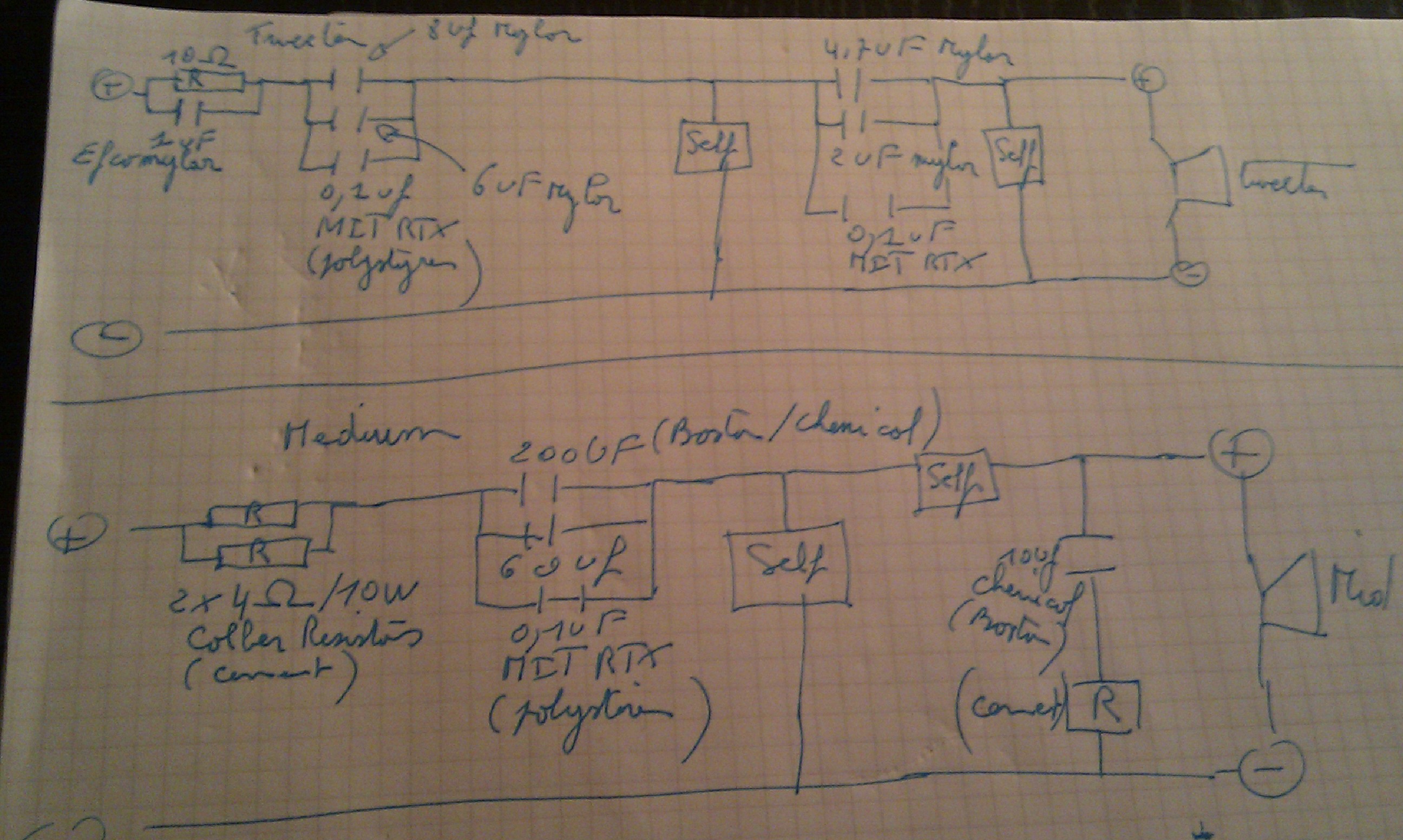
The 4th order crossover is an OK idea. It also gets 3dB or so level boost around 10kHz via that 1uF cap which is not really to explain the lump in brightness at 5kHz. That 5kHz peak can be addressed with a smaller second coil in the tweeter filter IMO. But the capacitors could probably be swapped around too.
But I can't do much without knowing the coil values and DC resistance of the tweeter, and maybe the same for the mid filters and mid itself, but I think the XO is the place to start. It looks like the tweeter is a bit bell-shaped in response, and Boston have tried to overfix this:
H1212-06 27TBFC/G
TBH, I think your 10R/33R resistor and 1uF experiments weren't addressing the real issues here.

Boston Acoustics Lynnfield 500L loudspeaker | Stereophile.com
It has a sort of mistuned phase plate called an AMD in front of the tweeter which creates a notch at 25kHz. All a bit weird. Looks like smoke and mirrors to me. 😕

The 4th order crossover is an OK idea. It also gets 3dB or so level boost around 10kHz via that 1uF cap which is not really to explain the lump in brightness at 5kHz. That 5kHz peak can be addressed with a smaller second coil in the tweeter filter IMO. But the capacitors could probably be swapped around too.
But I can't do much without knowing the coil values and DC resistance of the tweeter, and maybe the same for the mid filters and mid itself, but I think the XO is the place to start. It looks like the tweeter is a bit bell-shaped in response, and Boston have tried to overfix this:
H1212-06 27TBFC/G
TBH, I think your 10R/33R resistor and 1uF experiments weren't addressing the real issues here.
Last edited:
Thank you for your visit here 🙂
The shematic is the original one. I changed few things : the tweeter resistor has 0.5 ohm less but is a biwired.
I added a notch around 4 Khz
I added stuffing in the teweeter domes
I changed the Zobel in the mid (marked 10 uF but both channels exactly measure 9 uF instead) by SCR MKP (the smoothest MKP I know, sound like mylar buth better ESR)
I swapped the two 4 ohms résistors at the beginning of the mid by two mox of 3R8 (instead cemented in paper genuine ones)
The MIT styren in // with the 260 uF in the mid was changed by an Audyn True copper cap I find less coldy.
I believe the peak at 600 Hz is a problem but I measured in swept tone without time Windows in Arta (I assume it's a fault in home environment)
In those measurements (the mast made) with a calibrated aMic and soundcard, the tweeter seems to dive at 19 K Hz; it's not like Stereophile measurement in the 500 L which has the same mid and tweet units but maybe different crossover. The measurement I made suggest 2000 Hz : I measured each driver with its filter as the speaker can be tri-Amped ! But the XO points seems the same than the 500 L on the paper 125 Hz/2500, Stereophiles as my measurement suggest more 2000 Hz though.
I bought these speakers 20 years ago in second hand, just the internal wires were changed for Qed silver, I reswapped it with copper silicon insulated from Oyaide...
I have two or three mails exchange with the former Tech Director when this line from Boston Acoustics were who is Phil Jones. It was maybe 4 years ago as a CEO of the company he created : a very nice and humble guy, he answered me rapidly without knowing me in my quest to tame the treble with a notch.
Maybe the quest can continue here, the speaker is sounding good with an incredible fastness and transparency but it lacks the sexy treble of my T33 tweeter I have in my Kef 104/2....
I have to draw the notch I added in the tweeter filter between the tweeter unit and the filter above shematic to be clearer.... (the sound improved at my ears, and with the internal damping of the cone tweeter as well despite the foame dome behind it on the magnet ! look at previous photographs in thi sthread).
The shematic is the original one. I changed few things : the tweeter resistor has 0.5 ohm less but is a biwired.
I added a notch around 4 Khz
I added stuffing in the teweeter domes
I changed the Zobel in the mid (marked 10 uF but both channels exactly measure 9 uF instead) by SCR MKP (the smoothest MKP I know, sound like mylar buth better ESR)
I swapped the two 4 ohms résistors at the beginning of the mid by two mox of 3R8 (instead cemented in paper genuine ones)
The MIT styren in // with the 260 uF in the mid was changed by an Audyn True copper cap I find less coldy.
I believe the peak at 600 Hz is a problem but I measured in swept tone without time Windows in Arta (I assume it's a fault in home environment)
In those measurements (the mast made) with a calibrated aMic and soundcard, the tweeter seems to dive at 19 K Hz; it's not like Stereophile measurement in the 500 L which has the same mid and tweet units but maybe different crossover. The measurement I made suggest 2000 Hz : I measured each driver with its filter as the speaker can be tri-Amped ! But the XO points seems the same than the 500 L on the paper 125 Hz/2500, Stereophiles as my measurement suggest more 2000 Hz though.
I bought these speakers 20 years ago in second hand, just the internal wires were changed for Qed silver, I reswapped it with copper silicon insulated from Oyaide...
I have two or three mails exchange with the former Tech Director when this line from Boston Acoustics were who is Phil Jones. It was maybe 4 years ago as a CEO of the company he created : a very nice and humble guy, he answered me rapidly without knowing me in my quest to tame the treble with a notch.
Maybe the quest can continue here, the speaker is sounding good with an incredible fastness and transparency but it lacks the sexy treble of my T33 tweeter I have in my Kef 104/2....
I have to draw the notch I added in the tweeter filter between the tweeter unit and the filter above shematic to be clearer.... (the sound improved at my ears, and with the internal damping of the cone tweeter as well despite the foame dome behind it on the magnet ! look at previous photographs in thi sthread).
Last edited:
It's getting a bit late to do much on this, but it seems like you've just fiddled around with improving components without changing things much.
FWIW, I would think the tweeter ferrofluid is drying up now. You can buy replacement stuff on eBay by all accounts.
I just had a quick model, and you can easily lower tweeter level and shape it a bit. You use target electrical slopes to do this, and you just have to know the DC resistance of the tweeter to get quite close, because the filter totally dominates the response with 4th order.
But I need to know the existing coil values and tweeter DC resistance to work out a filter shape, for sure. Attenuation can be more easily estimated.
FWIW, I would think the tweeter ferrofluid is drying up now. You can buy replacement stuff on eBay by all accounts.
I just had a quick model, and you can easily lower tweeter level and shape it a bit. You use target electrical slopes to do this, and you just have to know the DC resistance of the tweeter to get quite close, because the filter totally dominates the response with 4th order.
But I need to know the existing coil values and tweeter DC resistance to work out a filter shape, for sure. Attenuation can be more easily estimated.
Last edited:
Thanks Steve, indeed I have to change this FF.
I don't know how to calculate the coils value (time to invest in a dayton measurement kit as a part of my prefered hobby?). The only I have is the one I added in the notch : here shematic updated. Notice I gave up the origina cap in // with the input attenuation resistor, just becaue I found it was better at ears without it...
I don't know how to calculate the coils value (time to invest in a dayton measurement kit as a part of my prefered hobby?). The only I have is the one I added in the notch : here shematic updated. Notice I gave up the origina cap in // with the input attenuation resistor, just becaue I found it was better at ears without it...
Attachments
Last edited:
just for the culture, mine is between those two speaker, but share the same mid&tweet unit you can see at the right....

The next speaker will be DIY of course and High effcienty.... here 85 dB/2.83V/m ! Hey but it is snappy and resolve like a planar with a quicky midbass...

The next speaker will be DIY of course and High effcienty.... here 85 dB/2.83V/m ! Hey but it is snappy and resolve like a planar with a quicky midbass...
Last edited:
--- was waiting Ferrofluid bought in Australia, but my local distributor Post Office via Chronopost get back to Australia the package by error ! The malediction of French Post : the factor rules the institution 😱  !
!
To be continued !
Could someone tell me if it Worth to swap the chemical in serie in the mid (260 uF iirc in the shematic linked above by a MKT or MKP ESA from Clarity cap ? I'm suspicious about ESR when it comes two swap two caps technologies !
Thanks if any idea : I was also thinking to the russian K73-16 MKT in 22 uF /60 v in // !!
 !
!To be continued !
Could someone tell me if it Worth to swap the chemical in serie in the mid (260 uF iirc in the shematic linked above by a MKT or MKP ESA from Clarity cap ? I'm suspicious about ESR when it comes two swap two caps technologies !
Thanks if any idea : I was also thinking to the russian K73-16 MKT in 22 uF /60 v in // !!
Btw way, what is making a resistor in // with a cap putted in serie in the tweeter filter please ?
Does it climb a part of the treble curve when the impedance curve falls or the Fhz curve falls ???? Not clear to me despite re reading the V Dickason book !
Any tips appreciated about this please, 🙂
PS : in the genuine filter a 10R was // with a 1 uF Mylar from Epcos : http://www.diyaudio.com/forums/multi-way/240636-acoustical-filter-tweeters-2.html#post3592382 (original shematic from this thread in a post above) ! I find it better without at ears !!!!! But the cement resistor was swapped by me with a Mundorf Supreme which is subjectivly clearer with more détails but gives also a subjectrive climbing treble ! (aluminium dome faulty ???)
Does it climb a part of the treble curve when the impedance curve falls or the Fhz curve falls ???? Not clear to me despite re reading the V Dickason book !
Any tips appreciated about this please, 🙂
PS : in the genuine filter a 10R was // with a 1 uF Mylar from Epcos : http://www.diyaudio.com/forums/multi-way/240636-acoustical-filter-tweeters-2.html#post3592382 (original shematic from this thread in a post above) ! I find it better without at ears !!!!! But the cement resistor was swapped by me with a Mundorf Supreme which is subjectivly clearer with more détails but gives also a subjectrive climbing treble ! (aluminium dome faulty ???)
Last edited:
The 10R//1uF lifts the top end a between 2-4dB above about 8kHz.
Bit perfectionist IMO. Possibly work better without the 1uF.
You'll be better off simming it really:
Downloads
boxsim-db.de | Boxsim Projektdatenbank
Import that project into projekte folder and mod it. I uses a W170S 8 ohm and a DSM 25 FFL. Must be vaguely similar.
If a tweeter is overly bright, you might lose the 1uF, and add some shunt element at the tweeter. 22R here, or a sloping zobel like 7.5R and 0.68.
You've gotta judge it yourself.
I have this sim set up for your speaker, but I really can't remember exactly what I was doing there.
Bit perfectionist IMO. Possibly work better without the 1uF.
You'll be better off simming it really:
Downloads
boxsim-db.de | Boxsim Projektdatenbank
Import that project into projekte folder and mod it. I uses a W170S 8 ohm and a DSM 25 FFL. Must be vaguely similar.
If a tweeter is overly bright, you might lose the 1uF, and add some shunt element at the tweeter. 22R here, or a sloping zobel like 7.5R and 0.68.
You've gotta judge it yourself.
I have this sim set up for your speaker, but I really can't remember exactly what I was doing there.
Attachments
Last edited:
Tanks a lot System 7 ,
Without it sounds better indeed, at least in my room !
The plus was also to add the notch around 4/5 K, but surely phase suffered of this tweak ! Adding also medical cotton behind the aluminium gave improvement!
The problem with my measurement is I can't identify if it's really in the treble ?! Maybe it can be the huge peak I have around 600 or 800 Hz which are givinge some harmonics ringing... or I made a bad measurement (I didn't putt a delay !).
But where will you putt the 22R shunt please (cause easy to try) : just before the tweeter after the notch cellul or can I simply putt it before the filter on the plugs as the speakers can be tri Amped ?
Without it sounds better indeed, at least in my room !
The plus was also to add the notch around 4/5 K, but surely phase suffered of this tweak ! Adding also medical cotton behind the aluminium gave improvement!
The problem with my measurement is I can't identify if it's really in the treble ?! Maybe it can be the huge peak I have around 600 or 800 Hz which are givinge some harmonics ringing... or I made a bad measurement (I didn't putt a delay !).
But where will you putt the 22R shunt please (cause easy to try) : just before the tweeter after the notch cellul or can I simply putt it before the filter on the plugs as the speakers can be tri Amped ?
Last edited:
- Status
- Not open for further replies.
- Home
- Loudspeakers
- Multi-Way
- acoustical filter for tweeters ?
